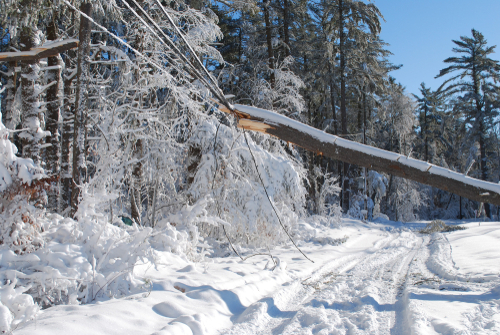For people in northern states, the winter usually brings along colder temperatures, snow, ice, rain, and strong winds. While everyone is inside of their warm homes sipping on hot cocoa, the trees right outside their windows are braving these harsh conditions. Even though trees are dormant during the winter, many factors contribute to winter tree damage.

Low Temperatures
Different trees have different temperature tolerance. As the temperature lowers, the chance for damages increases. This is especially true if the tree is not native to the climate area. Native trees are accustomed to low temperatures and have a better chance of surviving the winter. A tree that is not accustomed to the low temperatures will most likely freeze and become permanently damaged or destroyed.
Fluctuating Temperatures
Temperatures also drastically fluctuate throughout the day during the winter. When temperatures are constant, or slowly change over a period of time, trees have time to adjust. When temperatures change drastically over a small period of time, the tree doesn’t have time to acclimate to the new climate. The result of that could be sunscald or frost cracking, both of which causes damage to the tree.
Snow and Ice
Trees that are accustomed to snowfall will usually be okay. It’s only when the snowfall becomes excessive and builds upon the trees’ limbs that it poses a problem for the tree. Snow in a concentrated area can become rather heavy, and if that concentrated area is on the trees’ limb, you could be looking at falling or cracked tree limbs. This also applies to ice on the tree. A little bit of ice is okay, a lot of it is not. To avoid a buildup of snow and ice on your trees, be sure to gently knock it off with a stick, shovel, or anything else that will reach the snow.
Winter Dryness
Just like our lips and our skin become dry during the winter, trees can dry out in the winter too. Trees struggle to find moisture in the air and the soil and this means that they become dryer. This is especially true with Evergreen trees. This condition, known as winter burn, browns the needles of Evergreen trees. In severe cases, it causes irreversible damage to the tree.
What You Can Do To Protect Your Trees This Winter
If you are looking to preserve your trees throughout the winter, it’s best to contact a professional tree service. Hagan & Sons understands the importance of proper tree maintenance in MD throughout the winter and we work hard to protect your precious trees. Contact us today for a free estimate!
